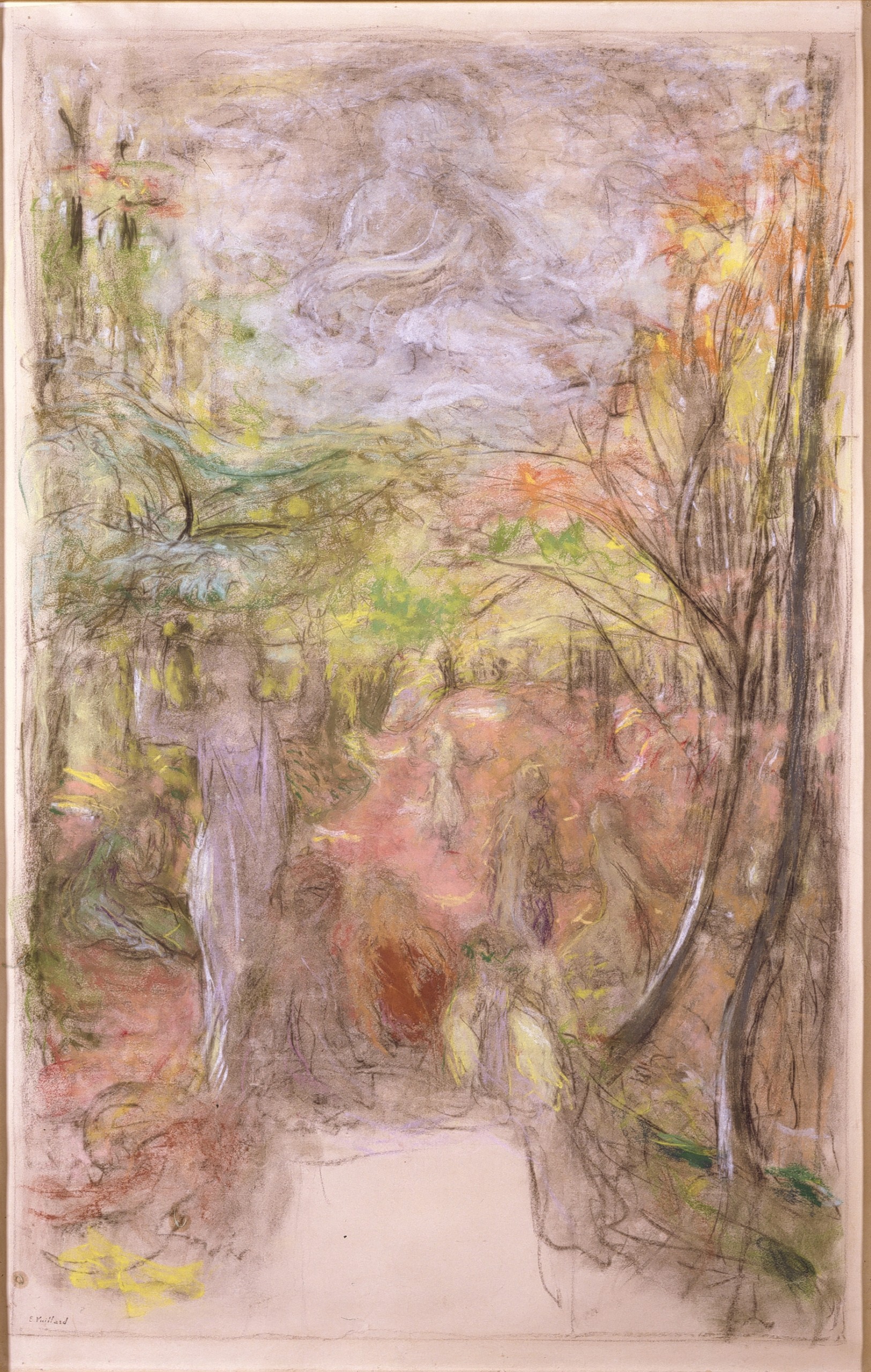Project Description
Édouard Vuillard
Cuiseaux, Saône-et-Loire 1868 – 1940 La Baule, Loire-Atlantique
L’Allée, a study for Pax Musarum Nutrix (Peace Protecting the Muses)
Pastel and charcoal on paper
Stamped with estate stamp, lower left, E.Vuillard
42 ½ x 27 inches
Executed 1937
Provenance:
Ker-Xavier Roussel (brother-in-law of Vuillard)
By descent in his family
Gallery Felicie, New York
Private Collection, Northampton, MA (purchased January1984)
This beautiful, large-scale pastel is a study for Peace Protecting the Muses, Vuillard’s important late commission from the French government for the League of Nations in Geneva, which also included works by Maurice Denis, Ker Xavier Roussel and Roger Chastel. Executed 1937-1938, the series was donated to the Palais des Nations, Geneva, installed in the Assembly Hall in 1939. The League of Nations was transformed into the United Nations in 1960. The murals are now in United Nations Library.1 This is the most finished of the Vuillard’s known studies.2
The gigantic scale of the commission made it the largest decoration the painter undertook. Vuillard had always wanted to confront the challenge of public art. His admiration for Puvis de Chavannes and his murals is well documented. And Puvis provided a model of sorts, a guide for Vuillard‘s studies of this ambitious project. After the iconographic program of the virtues of Peace was decided, Vuillard was assigned the subject of Pax Musarum Nutrix. Although Puvis provided the inspiration, Vuillard also owes a great debt to Roman models. The vertical format—11 meters tall—naturally called for a series of registers, which one can see worked out in the large preparatory pastels. These studies also document the artist’s hesitations about a final composition. The pastel technique was of particular help to Vuillard in enabling him to work out his composition. Finally to clarify his plans, he carefully wrote out the program in his sketchbook. 3
Although Vuillard moved with his family to Paris in 1878 under modest circumstances, he won a scholarship to attend the Lycée Concorcet, considered one of the best schools in Paris and in France. Other students included Maurice Denis, Paul Verlaine, Henri Bergson, Marcel Proust and Ker Xavier Roussel, another future painter and his future brother-in-law. On the advice of Roussel, Vuillard left the Lycée in 1885, joining him in the studio of Diogène Maillart. After three unsuccessful attempts, Vuillard entered the École des Beaux-Arts in 1887. The 1890s would be an important period for the artist. In 1890 Vuillard met Pierre Bonnard and Paul Sérusier and joined the Nabis, a group of art students inspired by the synthetism of Gauguin. They chose “Nabi”—Hebrew for “Prophet”—because they understood they would be creating new forms of expression. Vuillard contributed to Nabi exhibitions and shared a studio with fellow Nabis Bonnard and Maurice Denis. In the early
1890s he worked for the Theatre de l’Œuvre designing settings and programs. In the 1890s Vuillard also met the brothers Alexandre and Thadée Natanson, the founders of the Revue Blanche. On their advice, Vuillard painted his first decorations in 1892 for the house of Mme. Desmarais. This was the first of many commissions: in 1894 for Alexandre Natanson, in 1898 for Claude Anet, in 1908 for Bernstein, and in 1913 for Bernheim and for the Théâtre des Champs-Elysées.
Vuillard Page 2
Vuillard first exhibited at the Salon des Independents of 1901 and at the Salon d’Automne in 1903. Vuillard kept a journal throughout his life, from 1888–1905 and later from 1907 to 1940 in which he carefully documented both daily and important events.4 Private and public commissions continued throughout his career. His last commissions were in 1937-38 for the Palais de Chaillot, Paris (with Bonnard); and for the Palais des Nations in Geneva with Denis, Roussel and Chastel.
In his paintings and decorative pieces Vuillard depicted mostly interiors, streets and gardens. Marked by a gentle humor, the present work is executed in a delicate range of soft, blurred colors characteristic of his art. Vuillard lived with his mother, a dressmaker, until the age of sixty. Vuillard was very familiar with interior and domestic spaces. Much of his art reflected this influence, largely decorative and often depicting very intricate patterns.
The pastel will be included in the forthcoming supplement to the critical catalogue of works by Edouard Vuillard to be published by the Wildenstein Institute. It comes with a certificate (Ref. 12.03.29/11599) from the Institute signed by Colette Salomon on behalf of the Comité Vuillard. There is also a photo-certificate endorsed by Antoine Salomon from March 1984.
- The decorations were donated by the Government of France. The wall paintings, portraying the Virtue of Peace, were assigned to four painters: Roger Chastel, Pax genitrix (The Richness of Peace), Maurice Denis, Fiat in Virtute tua (Let Peace be Your Strength), Édouard Vuillard, Pax musarum nutrix (Peace as Protectorate of the Nine Muses) and Ker Xavier Roussel, Pacis alumna Ceres (Ceres Pupil of Peace). Cf.. Antoine Salomon and Guy Cogeval, The Inexhaustible Glance. The Critical Catalogue of Paintings and Pastels. Milan-Paris (The Wildenstein Institute) 2003, vol. 3, p.1529, no. XII-42.
- Guy Cogeval, et al. Édouard Vuillard, exhib. cat. New Haven (National Gallery of Art and other venues) 2003, pp. 350-353, nos. 294-296.
- Cf. Cogeval, op. sit. (cat. rais.), 2003, no. XII.142
- The journals, consist of more than fifty extant volumes, Institut de France, Paris: Volume I, part 1 (1888-1890); part 2 (1890-1906); Volume II, 1907-1916; Volume III, 1916-1922; Volume IV 1929-1940. Daily entries for the decade between 1896-1906 remained unaccounted for. There are, however, two chronologies included within the journals, written by the artist, in 1905 and 1908. Cf. Guy Gogeval, et al. Édouard Vuillard, New Haven (National Gallery of Art, Washington) 2003, p. xvii.

